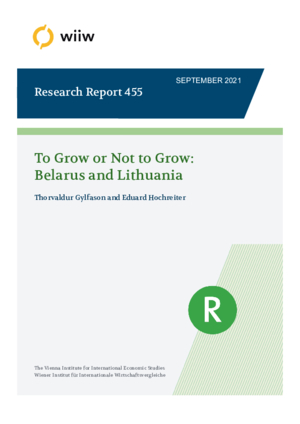To Grow or Not to Grow: Belarus and Lithuania
Thorvaldur Gylfason and Eduard Hochreiter
wiiw Research Report No. 455, September 2021
38 pages including 1 Table and 15 Charts
We compare the economic growth performance of Belarus and Lithuania since the collapse of the Soviet Union in 1991. Our interest in this country pair is driven by the two countries´ interwoven histories as well as by the fact that Belarus remains autocratic and strongly tied to Russia, while Lithuania has reinvented itself as a democratic market economy fully integrated into the EU. Our aim is to better understand the extent to which the growth differential between the two countries can be traced to increased efficiency, i.e., total factor productivity, in the use of capital and other resources via, inter alia, better institutions (intensive growth) as opposed to sheer accumulation of capital (extensive growth), the hallmark of Soviet economic growth. To this end, we compare the development of some key determinants of growth in the two countries since the 1990s. A simple growth accounting model suggests that advances in education at all levels, good governance, and institutional reforms have played a more significant role in raising economic output and efficiency in Lithuania than in Belarus, which remains marred by problems related to weak governance as well as autocratic rule. Further, as in Estonia and Latvia, the EU perspective has made a significant contribution to growth in Lithuania. The Russian connection has done less for Belarus. Finally, we touch upon the impact of the corona virus on the economies of the two countries.
Reference to wiiw databases: wiiw Annual Database
Keywords: Economic growth, Belarus, Lithuania, Governance, Transition economies, Education, Economic reforms, Exports, Inflation, Labour markets, Corona virus
JEL classification: O11, O16, O19
Countries covered: Belarus, Lithuania
Research Areas: Macroeconomic Analysis and Policy, Labour, Migration and Income Distribution, International Trade, Competitiveness and FDI, Regional Development
